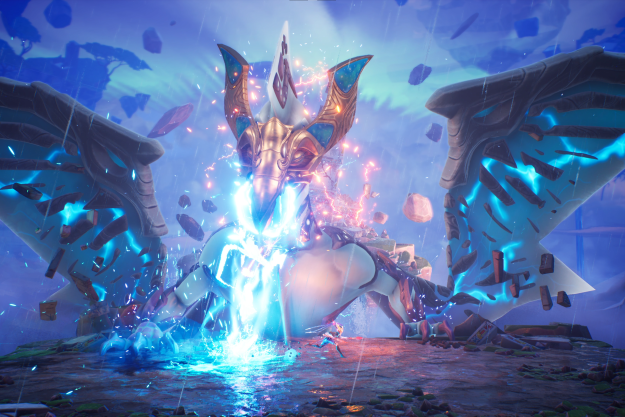
- Emotional story
- Nuanced hero
- Fluid movement and combat
- Gorgeous 2.5D environments
- Linear to a fault
- Backtracking is a pain
- Lacking enemy variety
As I sit down to write about Tales of Kenzera: Zau, I’m immediately at a loss for words. My instinct is to open with some wisdom about the act of grieving, the painful process that’s at the center of Surgent Studios’ debut. The longer I rack my brain for the perfect words to describe it, the more I come to accept that there is no universal truth. Grief is a messy emotion that takes each person wandering down different paths. The only thing that’s consistent about it is that it’s a journey.
Surgent Studios founder Abubakar Salim adapts that feeling in Tales of Kenzera, a deeply personal project created after his father’s passing. Here, Salim reimagines his own grieving process as a richly detailed 2D Metroidvania steeped in Bantu culture, one filled with both physical and mental battles. It’s a fantastical adventure, but there’s honesty in that approach. How else can you express the larger than life emotions that grief can bring?
Tales of Kenzera: Zau tells an emotionally impactful story reinforced by creative design decisions that put a physical feeling to abstract emotions. Its struggles lie in its approach to the Metroidvania genre, as its surprisingly straightforward structure sometimes undercuts the winding tale of acceptance. It’s an imperfect debut, but that’s fitting for a game about something as messy as grief.
The Shaman’s path
Tales of Kenzera: Zau opens with an effective frame tale that grounds its grander story. It begins in a futuristic city, where a man named Zuberi tends to his late father’s apartment. There, he finds a book that tells the tale of a Shaman named Zau, whose story parallels Zuberi’s. He’s also lost his father, but is dealing with it in his own way; he sets out on a quest to revive his Baba with the help of Kalunga, the God of Death. That setup makes Tales of Kenzera’s thesis clear from the jump: Grief is a story. While each person’s tale may look different, each contains valuable wisdom that we can gain by listening to one another. It’s like finding the moral in a fairy tale.
It’s easy to see the big spiritual picture.
That idea works as well as it does thanks to an emotionally honest story that tackles its subject from several angles. Even if you didn’t know the well-publicized inspiration behind the project, it’s clear that it was born out of a raw, open place. Zau, and the characters he meets along his journey, all deal with the stages of grief. The revival quest begins from a place of denial and bargaining and works its way towards acceptance, though it isn’t so rigid about that process. The ending of Zau’s journey isn’t fully written; the future is his to shape.
Zau is a perfect hero for that story. He’s an imperfect protagonist who is given room to be a relatable mess. Early on, he’s brash and selfish in his quest. The first chapter sees him chasing down a young girl who runs away scared from him. Completely blind to her fear, Zau ends up falling from a rickety bridge and is sent tumbling down a series of waterfalls. It isn’t just a classic video game diversion to pad out the play time — it’s a teaching moment. He has to climb out from his mistake, coming to terms with that flaw in his character. Each obstacle makes him stronger as he learns what it means to be a spiritual healer.

That dynamic highlights one thing Tales of Kenzera does especially well. While it deals in universal themes about grief, it’s also a celebration of Bantu culture. It examines the specific ways that the Bantu people deal with death, tying that into Surgent Studios’ own invented lore. Though we only see a slice of the world inhabited by a small handful of characters, it’s easy to see the big spiritual picture. It shapes the way Zuberi thinks about his own father’s passing in its frame tale. Hopefully, that wisdom will reach players too.
Let me get lost
In the lead-up to Tales of Kenzera’s launch, Surgent Studios made it clear that its gameplay decisions weren’t random. Salim says that the studio settled on the Metroidvania format because it mirrors the journey of grief. Players start in an unfamiliar world and learn to get a handle on it the more they grow. It’s a sound idea that makes the genre feel more meaningful, though the philosophy doesn’t always match up with the execution.
Tales of Kenzera is surprisingly straightforward compared to other games in the genre. Its various biomes play out in a mostly linear fashion, with a few short diversions along the way to grab collectible lore, skill-granting trinkets, and health upgrades earned from reflecting at a Baobab tree. Biomes don’t interweave and connect at multiple points; each has one single entrance and exit. It’s hard to get lost, let alone explore very much.

There are pros and cons to that approach. For those who find the maze-like nature of Metroidvanias intimidating, this is a much easier entry point. Its focus is more on crafting clear platforming challenges and puzzles that are satisfying to clear. There’s a fluid joy to clambering over tree branches or dashing between tree stumps that are perfectly placed over poisonous water. A concise set of extra abilities adds some smart puzzling to traversal too. When I get the ability to freeze water with an arrow, I have to use my brain to freeze waterfalls, turning them into surfaces I can wall jump off of. With fast, smooth movement that’s easy to control, players can zip to the next story beat.
That lost friction, though, seems a little counterintuitive to the emotional journey the genre is being used to parallel. There’s never a point where I feel like I don’t understand the world around me. It’s rare that I even hit a path blocked by an ability I’ve yet to find. Instead, I’m able to follow a marker on a clearly defined map and traverse every obstacle with the skills I have from the jump. Many objectives, like finding keys needed to open locked doors, have me completing a platforming gauntlet and then backtracking through it all again to get back to where I came from.
It all feels a little stiff and neatly defined by Metroidvania standards.
My toolset grows as I gain the ability to launch off of grapple points or smash through blocked walls, but the world doesn’t open up to me the deeper I get. It feels more like I’m playing a linear 2D adventure game with a set path. It’s great at delivering that, but it all feels a little stiff and neatly defined by Metroidvania standards. That feeling doesn’t pair so well with the comparatively complex journey.
Though the structure doesn’t quite match the story, Surgent Studios excels when it comes to creating richly detailed 2.5D environments. Rather than playing on the genre’s tropes (grassland, fiery cave, ice world, etc), Tales of Kenzera takes players to more thoughtfully constructed areas that each have their own look and feel. Wanderer’s Path is a bright and sunny starting area that’s built for introductory platforming. It feels like home, a safe area that keeps me in my comfort zone. Later, I find myself in the much darker Wildwood, a tangled forest lined with hidden traps and a foggy backdrop. It feels more dangerous and uncertain, paralleling the grief arc as the initially cocky Zau becomes more vulnerable in his emotional journey. I may be exploring narrow paths, but I can feel the depth that exists beyond those beautiful landscapes.
Battle-tested
Combat has its limitations too, but it’s starting from a much stronger foundation. Zau’s moveset revolves around two masks that he can flip between on the fly. The Sun mask lets him pull off standard hack-and-slash combos with a fiery twist, while the Moon mask lets him fire off arrows from afar. I can switch between those skills instantly in battle with the tap of a button, creating a fast-paced interplay between long-range and close-range attacks. Surgent Studios refers to that dynamic as a “dance,” and that idea fully comes across in fast, balletic combat encounters.
There’s some surprising depth to it all that reveals itself as Zau acquires more powers. By the final few hours, I can fire a flurry of arrows at a flying critter, hit it with an ice shot to freeze it in place, launch a spear at it, bash into it with my wall-smashing bash, and spend some spirit energy to hit it with a pillar of flame. That’s overkill for one measly enemy, but that level of self-expression makes a seemingly simple system feel much more complex.
This is the kind of marriage between play and meaning that every studio should strive for.
The only letdown here is that there aren’t a lot of great opportunities to show off. Tales of Kenzera features a fairly small number of monsters that reoccur in arena-like battles scattered throughout the map. The only added twist is that some creatures have elemental shields that require the right mask to crack, but there’s not much strategy beyond that. Thankfully, the adventure has a concise eight-hour runtime to match its small scale.
There are several spots where I can feel that Tales of Kenzera is a debut game, but others feel like Surgent Studios is already wise beyond its years. Combat and movement are both incredibly smooth, rising to match much bigger projects like Prince of Persia: The Lost Crown. Though what’s more notable is how nothing here feels like it’s simply fun for fun’s sake. Every decision connects back to either its exploration or grief or its tribute to Bantu culture. From a memorable soundtrack drawing on African tradition to trap-filled biomes meant to evoke anxiety, this is the kind of marriage between play and meaning that every studio should strive for.

While the adventure doesn’t always mirror its personal journey as strongly as it could, I reach the right destination by the end of Tales of Kenzera. Once I reach the final challenge, I feel like I’ve fully come into my own as I smoothly zip through platforming gauntlets and crush the final boss with ease. I’m left with a sense that the brash, sloppy Zau truly has grown in his journey. He hasn’t just learned to accept his Baba’s death, but gained the strength to carry forward and grow into his own as a Shaman. It’s as much a pivotal coming of age tale as it is a somber reflection on grief. When one chapter ends, another begins. Tales of Kenzera reminds its players to keep turning the page even when it feels like their story has reached its conclusion.
Tales of Kenzera: Zau was tested on PC and Steam Deck.
Editors' Recommendations
- All Baobab Tree locations in Tales of Kenzera
- Animal Well will be part of the PS Plus Game Catalog from day one




